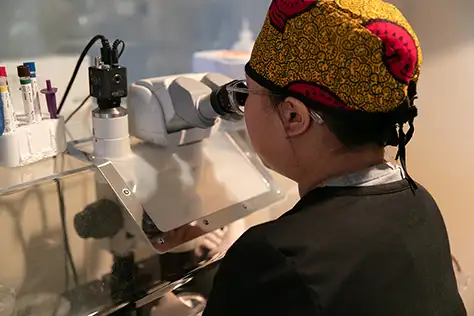SET - Single Embryo Transfer
The safest way to take home a single healthy baby.
Single Embryo Transfer for a Safe Pregnancy and Healthy Baby

For many who have waited a long time and undergone multiple fertility tests and treatments in an effort to conceive, any choice that maximizes having a positive pregnancy test is welcome. In the world of assisted reproductive technology (IVF), this too frequently translates to the transfer of multiple embryos in the hope that one will produce a positive result. While many couples may at first view multiple pregnancy (twins, triplets, quadruplets) as a safe and even desirable outcome, there are inherent risks involved.
Risks of Multiple Gestation
The greatest risk of multiple pregnancy is early labor and premature birth. While the average pregnancy length of a singleton is about 40 weeks, the average length of a twin pregnancy is 36 weeks, and that of a triplet pregnancy is 33 weeks.
More than 90 percent of triplet pregnancies are technically premature, and more than a third are severely premature (less than 32 weeks in duration). In fact, more than 75 percent of triplets require treatment at a Neonatal Intensive Care Unit (NICU) and are hospitalized on average for one month. With twin births, approximately 25 percent require a stay in the NICU. Unfortunately, many children born severely premature have persistent disabilities. Multiple gestation pregnancy also is associated with an increased risk of maternal complications, including gestational diabetes and pre-eclampsia, hypertensive disease of pregnancy that can lead to serious conditions like seizures.
Blastocyst Transfer
By limiting the number of embryos transferred, the risk of triplet pregnancies and higher-order multiple gestations (quadruplets or more) can be minimized, if not eliminated.
Our program is trying to lower the occurrence of twin pregnancies as well, which currently affects 40 to 50 percent of patients with the best prognosis, meaning females younger than 37 years of age or those using donor eggs. Good prognosis patients with embryos of excellent quality may be candidates to participate in our elective single blastocyst program. In this program, we take two or more embryos of high quality and cryopreserve, or freeze at least one.
Our data has shown that with the transfer of a single embryo, pregnancy rates are approximately 10 percent lower for the fresh cycle, but cumulative pregnancy rates for the fresh and subsequent FET cycles are equal. In other words, those couples that qualify for and undergo an elective single embryo transfer that do not conceive on their first try will usually conceive following the subsequent FET. This virtually eliminates the complications of twin pregnancies. The risk of twins is reduced from 40 to 50 percent to about 2 percent with a single embryo transfer, and the cumulative success rates remain about the same.
Dallas-Fort Worth Fertility Associates follows the guidelines defined by the Society for Assisted Reproduction (SART). SART associated practices adhere to the guidelines for assisted reproductive technologies (ART) and maintain strict compliance with the standards required for SART affiliation.